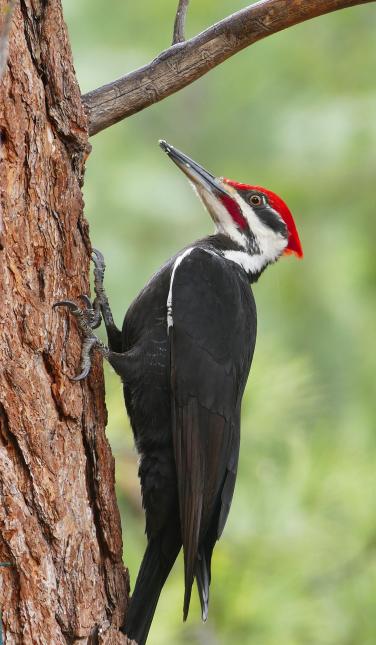Woodpeckers in Florida: Recognition Tips and Habitat Preferences
Woodpeckers in Florida: Recognition Tips and Habitat Preferences
Blog Article
Woodpeckers Unleashed: Exploring the Marvels of These Skilled Tree Mountain Climbers
Woodpeckers, with their distinctive markings and rhythmic drumming echoing through wooded areas, hold an one-of-a-kind location in the avian world. Their specialized composition and adaptations enable them to browse vertical surfaces with unmatched ability. Their proficiency of tree climbing is simply one element of their interesting behavior. As we look into the intricate information of woodpeckers' nesting habits, feeding techniques, and the ongoing conservation efforts to shield these amazing birds, a much deeper appreciation for their area in nature unravels.
Makeup and Adaptations
When checking out the composition and adaptations of woodpeckers, one can observe amazing features that allow these birds to prosper in their specialized environmental particular niche. Woodpeckers are furnished with a collection of unique anatomical features that assist them in their woodpecking actions. Among the most famous attributes is their strong, chisel-like beak, which is specialized for drilling into timber to uncover pests or create nesting tooth cavities. This beak is supported by solid neck muscular tissues and a highly created skull framework that works as a shock absorber, allowing woodpeckers to continuously eat trees without causing brain injury. Additionally, woodpeckers have zygodactyl feet, with two toes encountering forward and 2 encountering in reverse, supplying a company grasp on tree trunks while they look for food or drum for interaction.
Additionally, woodpeckers have an unique tongue structure that is long, barbed, and sticky, enabling them to remove insects from crevices in timber. This specialized adaptation enables woodpeckers to make use of a food source that is hard to reach to several other bird types. In general, the anatomy and adaptations of woodpeckers showcase the exceptional transformative services that have actually permitted these birds to flourish in their arboreal environment.
Drumming Behavior
Having actually explored the makeup and adaptations of woodpeckers, the focus now shifts to understanding their drumming behavior, a distinct aspect of their interaction and territorial display screens. Drumming is a vital type of interaction among woodpeckers, serving multiple functions such as developing regions, bring in mates, and signaling alarm system. Each woodpecker varieties has an unique drumming pattern that helps people acknowledge members of their own species and identify them from rivals or killers.
Woodpeckers create drumming sounds by rapidly pecking on powerful surface areas such as dead trees, utility posts, and even metal things, developing a collection of rhythmic beats. The strength and speed of drumming can vary based on the objective; for instance, a rapid drumming series may indicate aggressiveness towards burglars, while a slower and softer drumming pattern can suggest courtship (Woodpeckers in Florida). Furthermore, woodpeckers might readjust the regularity and period of their drumming to convey certain messages effectively
Nesting Routines
Checking out the nesting habits of woodpeckers reveals fascinating insights into their reproductive habits and environment choices. Woodpeckers are known for their one-of-a-kind nesting choices, usually excavating cavities in trees to produce protected spaces for elevating their young. These dental caries serve not only as a nesting website but additionally as a protected haven from predators and inclement weather.
Woodpeckers display a high degree of integrity to their nesting websites, commonly returning to the exact same area year after year. This habits highlights the significance of ideal environment availability for their reproductive success. The selection of a nesting site is critical for woodpeckers, with factors such as tree varieties, elevation, and decay phase playing significant functions in their decision-making process.
Surprisingly, find out here now some woodpecker varieties are known to dig deep into multiple dental caries within their territory, offering themselves with alternate nesting options. This strategy might serve as a form of insurance policy versus prospective hazards or disturbances to their main nesting site.
)
Feeding Strategies
Woodpeckers use a range of specialized feeding methods to procure their key food resources. One of the most unique feeding habits of woodpeckers is drumming, which entails rapid pecking on trees to uncover bugs underneath the bark. This drumming not only helps them locate prey but also serves as a way of interaction with other woodpeckers. Woodpeckers have strong, chisel-like beaks that enable them to pierce right into wood effortlessly. As soon as an opening is developed, they utilize their long, barbed tongues to extract insects such as ants, beetles, larvae, and spiders. These tongues are coated with sticky saliva that aids trap the victim. Woodpeckers are likewise known to dig deep into cavities in trees to gain access to hidden insect larvae or sap. Some types, like the acorn woodpecker, shop nuts in specifically created holes called granaries. This tactical storing of food aids them make it through during food scarcity durations. Woodpeckers are really exceptional in their feeding methods, showcasing adaptability and intelligence in obtaining their nutrition.
Conservation Efforts
In the middle of the intricate feeding strategies showed by woodpeckers, the conservation efforts aimed at safeguarding these remarkable birds play an important function in protecting their habitats and populaces. Woodpeckers face different hazards to their survival, consisting of habitat loss due Woodpeckers in Florida to deforestation, environment modification modifying their ecosystems, and crashes with manufactured structures such as buildings and vehicles - Woodpeckers in Florida. Guardians are actively working to deal with these obstacles and guarantee the long-term wellness of woodpecker species

Education and public recognition campaigns are also important parts of woodpecker preservation efforts. By raising recognition concerning the importance of these birds in preserving healthy forest communities, guardians can garner support for environment conservation efforts and advertise responsible land monitoring techniques. Via collaborative initiatives in between researchers, policymakers, and neighborhood communities, we can collaborate to secure a future where woodpeckers thrive in their all-natural environments.
Conclusion

Report this page